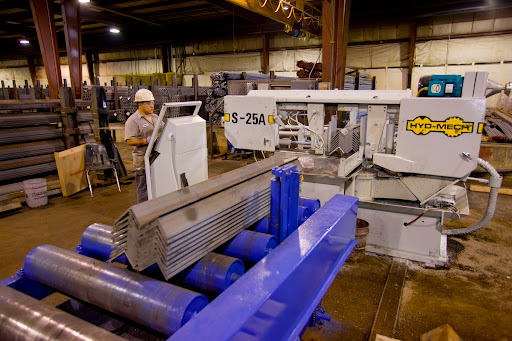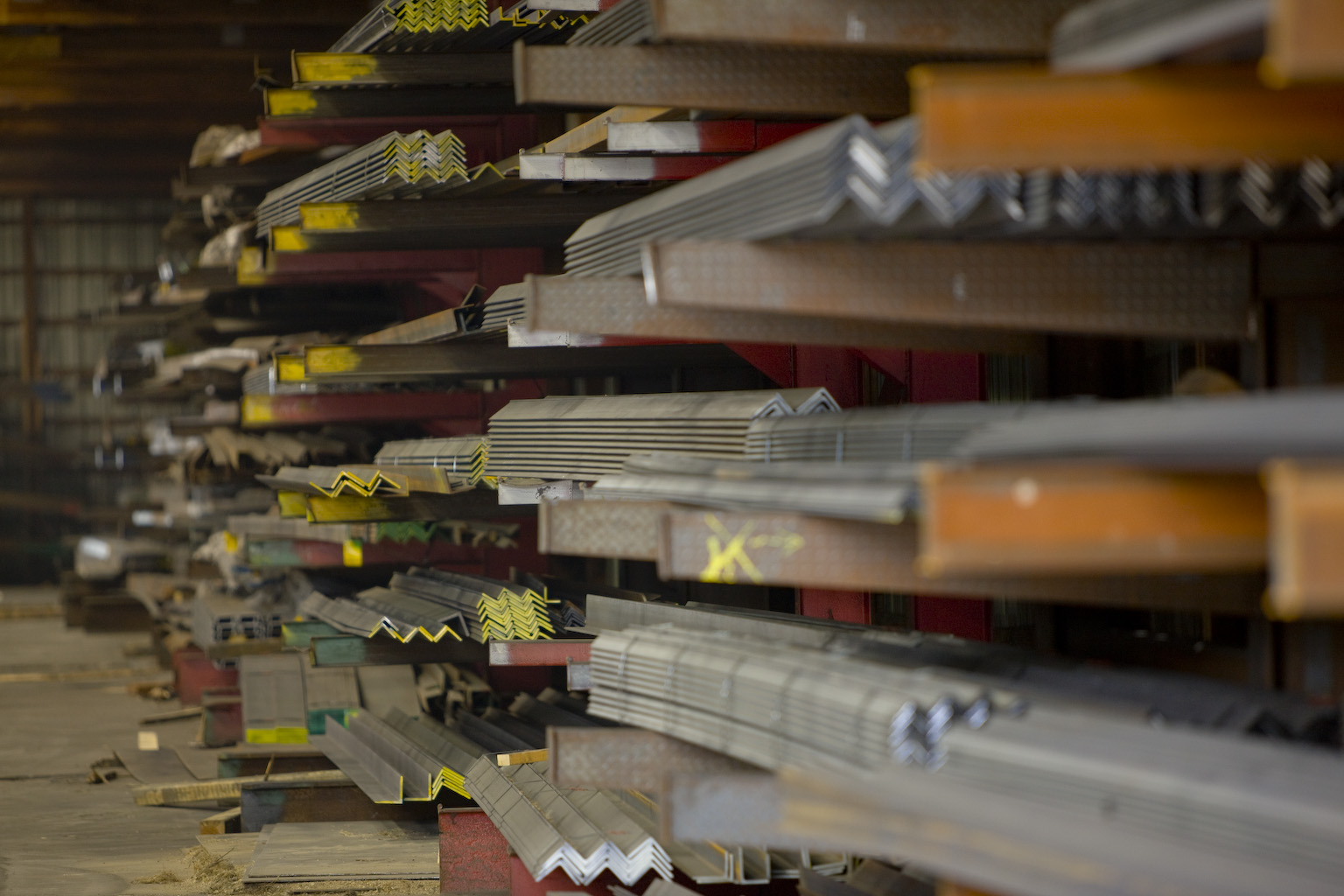merchant bar quality
| GRADE | SIZES |
|---|---|
| ASTM A-36 | 1/2" x 1/2" x 1/8” up to 2-1/2" x 2-1/2" x 1/2" | Lengths up to 40’ |
structural
| grade | sizes |
|---|---|
| ASTM A-36 | 3” x 2" x 3/16” up to 8” x 8” x 1-1/8” | Lengths up to 60' |
Steel angles are literally and structurally the cornerstones of thousands of fabrication, construction, and manufacturing applications. From framing and bracing to support systems and architectural reinforcements, an L-shaped profile brings the strength, versatility, and adaptability many professionals demand. Westfield Steel supplies steel angles in a wide range of sizes, grades, and configurations, and our in-house fabrication team customizes every piece to meet your requirements. Whether your project calls for A36 steel angle sizes or higher-strength grades like ASTM A572, work with a steel supplier delivering production-ready steel angles with precision cutting, punching, notching, and shearing services that ensure a perfect fit and fast installation.

Standard steel angle sizes meet the demands of many structural and manufacturing applications. However, there are countless situations where off-the-shelf options fall short. Precision projects involving irregular assemblies, complex geometry, or tight tolerances often call for angles beyond traditional specifications. Custom steel angle fabrication capabilities save time, streamline installations, and reduce jobsite or production floor errors.
Unlike stock profiles, custom-fabricated angles allow engineers to define dimensions, cut styles, and feature configurations specific to the final application. Adjustments might include an unconventional leg length, a nonstandard angle degree, or a unique radius and beveling for component integration. In these cases, the ability to customize every aspect of the steel angle ensures the final product matches design intent without costly modifications in the field.
Custom fabrication reduces the risk of installation delays and performance errors. When steel angles arrive pre-drilled with an exact hole pattern or pre-notched to accommodate mating parts, crews avoid jobsite cutting or retrofitting that can compromise precision and safety.
Beyond structural accuracy, custom steel angles also streamline project workflows. Receiving material your steel supplier has already cut, shaped, and processed to specification minimizes unnecessary labor and material waste. This approach greatly benefits production environments that demand consistency, repeatability, and speed. When teams tailor angles for specific fixtures, machinery, or subassemblies, they accelerate the process and reduce errors, lowering total costs and strengthening final products.
While many steel angle applications still rely on common carbon steel grades such as A36, others demand high-strength or corrosion-resistant options like ASTM A572 or galvanized finishes. Custom fabrication allows for pairing exact specifications with the appropriate material properties, providing mechanical performance and environmental durability. The result is a component that fits and performs with resilience and consistency in demanding conditions.
Custom-fabricated steel angles serve a wide range of industries and uses. They form unique connections within steel framing systems, curtain walls, or modular panels in construction. In manufacturing, they provide reinforcement or alignment within machinery frames and enclosures. Architectural designers specify them for clean-line detailing or decorative structural elements. Even small adjustments, such as slotting for adjustable connections or shortening for tight clearances, can make standard materials more functional and installation-ready.
The precision of custom fabrication also enables better integration with fasteners and support systems. Bolts, rivets, welds, and brackets depend on proper repeatable alignment. With pre-configured hole placements or edge treatments, steel angles become part of a seamless system rather than a component that requires adaptation.
Custom fabrication is all about controlling every aspect of steel angles, such as size, shape, material, and features, without compromising the application’s needs. It can enhance structural integrity, simplify assembly, reduce waste, and support design innovation. Custom angles make it possible to precisely align form and function, especially when standard options fall short.
LEARN MORE: ADVANCED PRECISION CUTTING AND FABRICATION
Steel angles are essential across construction, manufacturing, infrastructure, and industrial environments. However, with many material grades, sizes, and finish variations, selecting the right steel angle requires more than knowing dimensions. Whether designing a structural frame, reinforcing equipment, or fabricating custom supports, teams must align performance characteristics with safety, longevity, and installation goals.
The L-shaped profile is simple in form but powerful in function. Steel angles provide resistance along two planes, yet their performance varies significantly depending on grade, thickness, leg length, and finish.
Small mismatches in dimensions or finishes can lead to failures in framing systems, connection points, or support structures. For instance, long-leg angles are ideal for mounting and welding, while short-leg options help fit tight spaces. Higher gauges can absorb more stress but may require specialty handling.
For projects demanding frequent bolt-on components—such as racking systems, brackets, or adjustable supports—uniform hole patterns or pre-drilled features help ensure alignment, speed assembly, and reduce jobsite fabrication.
Galvanized or coated finishes help steel angles resist corrosion in outdoor or humid environments. Stainless or other specialty alloys offer protection against chemicals, salt, or extreme temperatures. Selecting a finish based on where and how the steel angle will operate helps extend service life and reduce maintenance cycles.
Engineers and purchasing teams should also consider future flexibility. If a design may require later expansion or modification, selecting a more adaptable or customizable angle profile allows for easier changes without requiring a complete redesign or replacement.
There is no single steel angle that fits every job. The most effective choice depends on how well it balances structural load, environmental durability, assembly ease, and long-term adaptability.
Consider the following:
You can incorporate pre-drilled holes, slotted profiles, and bevels to simplify alignment and improve installation speed. These options also reduce rework in the field and support consistent performance over time.
By planning for lifecycle needs—whether that means accommodating expansion, relocation, or service access—engineers and purchasing teams can specify steel angles that enhance overall system reliability and reduce total cost of ownership.
Refer to the table below to evaluate common sourcing and specification factors for steel angles.
| Steel Grade | Yield Strength | Typical Use Cases | Weldability | Cost |
|---|---|---|---|---|
| ASTM A36 | 36,000 psi | General structural use, light framing, platforms | Excellent | $$ |
| ASTM A529 | 42,000–50,000 psi | Medium-load bearing, columns, supports | Good | $$$ |
| ASTM A572 | 50,000–65,000 psi | Heavy-duty bracing, load-bearing structures | Good | $$$$ |